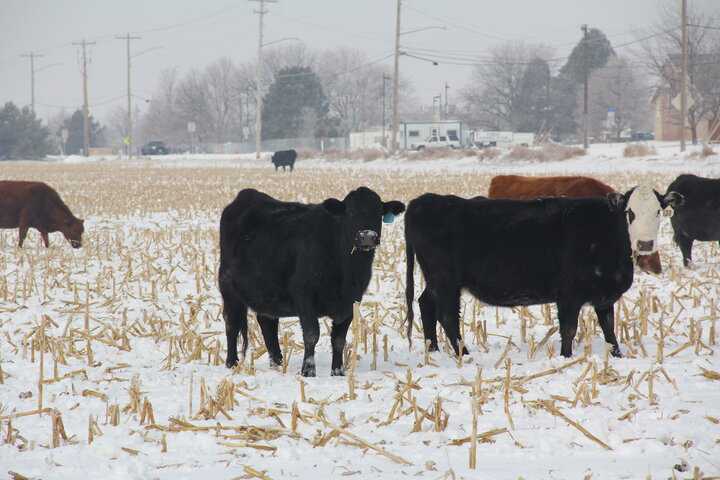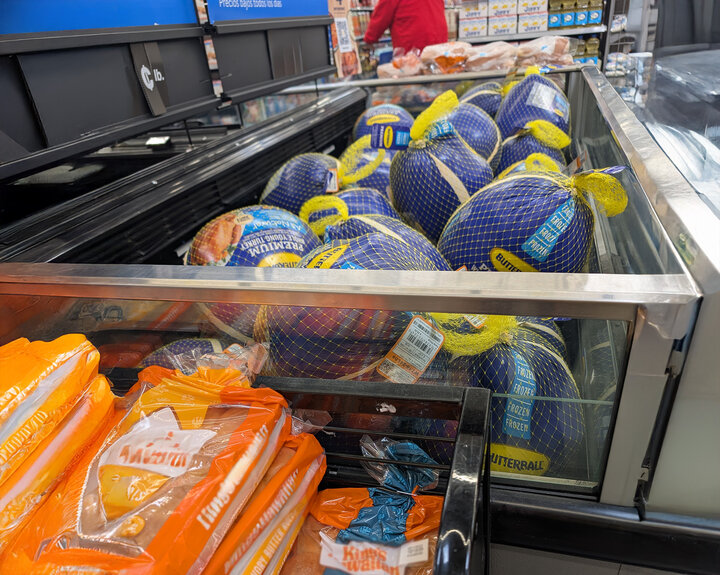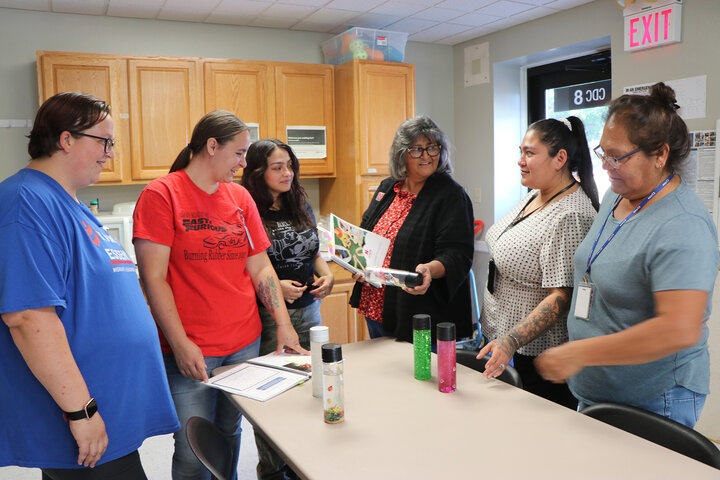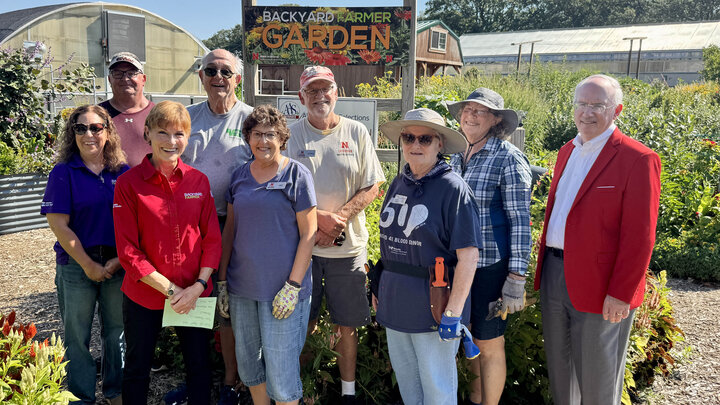Local Interest

Keys for Corn Stalk Grazing
By Aaron Berger, Nebraska Extension Educator
Nebraska has 10.5 million corn acres and 1.5 million beef cows - more than enough acres of corn residue for grazing beef cows through the winter.
Scouting fields before grazing is important to determine the amount of corn present and to look for spilled corn that could cause grain overload, which could result in cattle bloat or death. If there are more than 8-10 bushels of corn on the ground per acre as ears of corn, a grazing strategy to control corn intake will need to be used to minimize grain overload risk. When there is a minimum of ears of corn on the ground, the number of cattle to be grazed and the length of time for grazing should be determined based on corn bushel yield per acre and the average weight of cattle. The UNL Corn Stalk Grazing Calculator is an Excel® spreadsheet that can be used to calculate this. A quick way to estimate grazing days per acre available for a 1200-pound non-lactating cow is to take the corn bushel yield and divide by 3.5. For example, 180-bushel yield / 3.5 = 51 grazing days per acre.
Cattle tend to select for downed corn first and then seek out husk and leaves. The quality of grazing starts high at approximately 70 percent total digestible nutrients (TDN) and then decreases to a low of 45 percent TDN at the end of the grazing period. The rate of quality decline is dependent on stocking rate and environmental factors such as moisture and field conditions. Mature non-lactating, spring calving cows in a body condition score 5 or better will not need protein supplement, but will need salt, mineral, and vitamins when grazed at Nebraska Extension recommended stocking rates.
First-calf heifers within 90 days of calving will need protein and energy supplementation to meet nutrient requirements. Feeding 3.5 lbs. per head per day of dried distillers grains will meet this need. Fall-calving cows will also need additional protein and energy to meet nutrient requirements. Feeding 5 lbs. per head per day of dried distillers grains would supply this need. Grazing weaned calves with a targeted gain of one pound per day will need to be fed an energy and protein supplement. Research has demonstrated that dried distillers grains fed at 2 lbs. per head per day to calves will usually meet this targeted level of gain. Deep snow and ice can severely limit cattle's ability to graze corn residue. Have a backup plan and other feed resources available to meet cattle feed needs when this occurs. Corn residue can be an excellent, economical resource for late fall and winter grazing in many parts of the state.
nowing the keys for grazing can help producers effectively utilize it. The Nebraska Extension Circular Grazing Crop Residues with Beef Cattle provides additional information for grazing corn residue.

Holiday Meals on a Budget: Eating well without overspending
By Ashley Fenning, Nebraska Extension Foods, Nutrition and Health Instructor
As the calendar turns to the last month of 2025, many families are looking forward to the holiday season spent with family, friends, and food. But with grocery prices still higher than usual, many households are searching for ways to stretch their food dollars without sacrificing the joy of a special meal. The good news? A meaningful holiday table doesn’t require a big budget, just thoughtful planning and a few creative strategies.
Shop Smarter, Stress Less
Whether you are shopping online or in-store, holiday shopping can be stressful—not only on your wallet but also on your mind. Here are some ways to tackle stress this holiday season:
- Buying in bulk isn’t always the cheaper option. Check the cost per ounce, pound, or unit rather than assuming bulk is more affordable.
- Read nutrition labels to find items with lower sodium, saturated fat, trans fat, and added sugars.
- Stick to your grocery list. Take the time to plan your menu and write down the ingredients you need.
- Use reward points or look for sales on specific food items.
- Buy generic or store-brand items.
- Avoid convenience foods (premade or preprepared items), which often cost more.
- Don’t shop hungry!
For more resources, visit: https://thedishrealtalk.com/
Building a Holiday Meal for Under $20
Depending on how many people you’re preparing a meal for, the best place to start your menu planning is by choosing a protein source. Protein is typically the most expensive part of a meal, so selecting affordable options can significantly reduce your total cost. When shopping for meat, be sure to compare the cost per serving, not the cost per pound. Budget-friendly protein sources include less tender cuts of beef, such as round, chuck, or shoulder; specific cuts of chicken; small boneless hams; dry or canned beans; eggs; and even canned seafood, such as tuna or salmon. You can often stretch your budget even further by watching for holiday sales, or purchasing family-sized or value packs, and freezing what you don’t use right away.
Once you’ve selected a protein, build the rest of your menu around affordable staples like potatoes, carrots, beans, rice, oats, and seasonal squash. These foods keep costs low while still offering comfort and flavor. In addition to shopping holiday sales, consider choosing store-brand items, comparing unit prices, and using loyalty rewards to save even more.
Before heading to the store, take a quick inventory of what’s already in your pantry or freezer. Using ingredients you already have can spark menu ideas, reduce food waste, and keep your holiday meal well under $20. For larger gatherings, asking guests to bring a dish can also help stretch your budget and create a sense of shared community.
Waste-Reducing Tips
One of the best things about holiday food is stretching leftovers into future meals, but proper storage is key to keeping food safe. The last thing anyone wants is for someone to become ill during the holidays from a foodborne illness.
- Always wash your hands before handling any food.
- Refrigerate leftovers, especially meat, poultry, cooked foods, cheese, and cut-up fruits and vegetables, within two hours. Any food left out for longer than two hours should be discarded.
- Leftovers typically last up to four days in the refrigerator or 2–4 months in the freezer.
- Plan ahead for how you’ll use leftovers. Turn them into soups, sandwiches, or breakfast casseroles to help stretch your holiday food budget.
- When reheating leftovers, ensure the internal temperature reaches 165°F.
With a bit of thought and creativity, you can enjoy a delicious holiday meal that fits your budget and nourishes the spirit of the season. For more tips on using leftovers, visit food.unl.edu and search “leftovers.”
The holidays don’t have to be expensive or overwhelming to feel special. By planning, stretching what you have, and using thoughtful strategies to save money and reduce waste, you can create a holiday meal that brings satisfaction without the stress. Small choices can have a significant impact—both on your budget and on your peace of mind.

The 2025 Scotts Bluff County 4-H Achievement Program was held on October 19 at the UNL Panhandle Research Extension and Education Center in Scottsbluff. The event recognized the progress and growth of 4-H members and encouraged them to continue their development in life and leadership skills to become productive citizens. Adults were also recognized for providing youth development experiences and leadership to our clubs and members.
“By participating in club and project work, trips offered through the county, state, and nation, youth get to meet many new people, have chances to work together in close group atmospheres, and enhance their life skills,” said Audra Brown, 4-H Assistant.
The awards and recipients are as follows:

Nebraska Extension early childhood educator passionate about building strong families
By Chabella Guzman, PREEC Communications
Many Nebraska Extension educators are called to their positions. Jackie Guzman is no exception. She is the Nebraska Extension early childhood educator and lead educator in the Nebraska Extension Engagement Zone 1, located at the University of Nebraska-Lincoln Panhandle Research Extension and Education Center in Scottsbluff.
“It is a purpose, a calling for me. This is where we need to start with parents and children to build a solid foundation, where the children are ready to learn and more apt to graduate,” she said.
Among the programs Guzman provides to professionals is the CHIME (Cultivating Healthy Intentional Mindful Educators) program. It is an eight-week program that focuses on the person working with young children, providing them with the skills to work effectively with children by first helping themselves through mindfulness.
Guzman has developed and implemented programs for non-traditional audiences while incorporating traditional 4-H curriculum and methodologies for youth. One such program is embryology, which includes Extension 4-H educators. “I provide incubators, and the farmers provide eggs. There is a curriculum with activities for elementary school children and early childhood/preschool programs,” she said.




